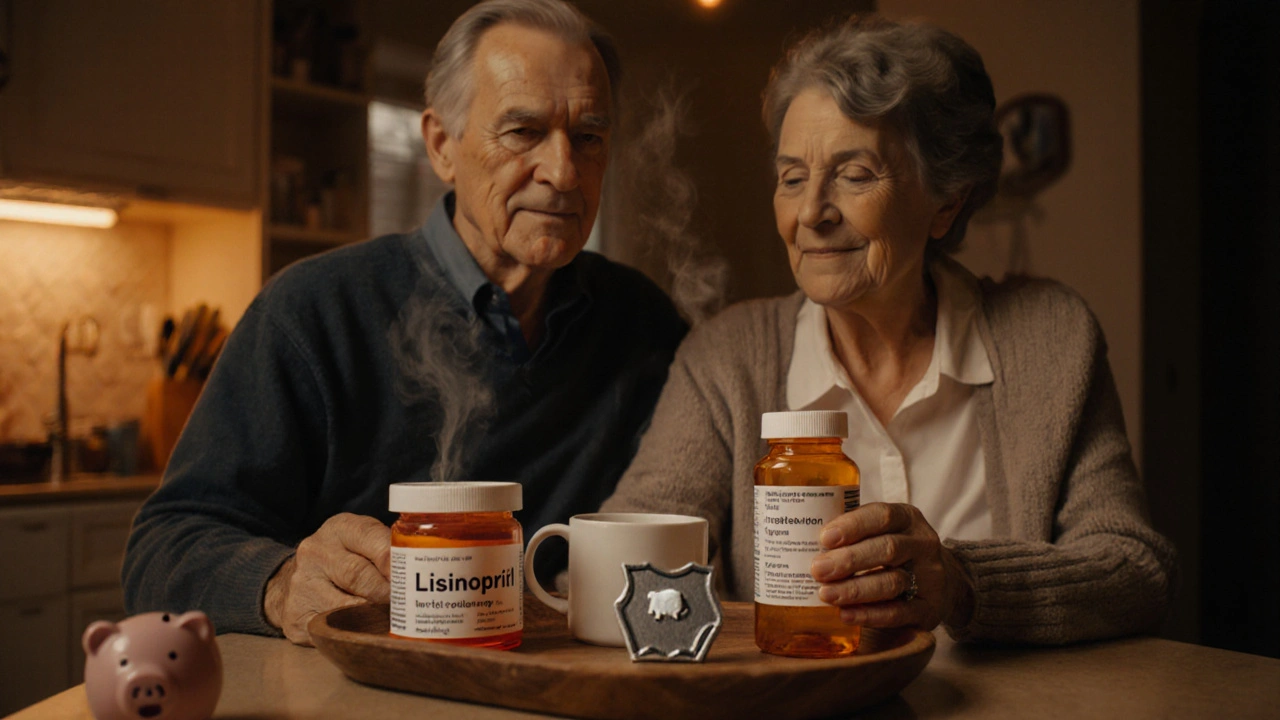Blood Pressure Medication Comparison Tool
Select a medication to compare its features with Lisinopril:
Lisinopril comparison can feel like navigating a maze of medical jargon, especially when you’re trying to keep your blood pressure in check. Below is a quick snapshot of what you’ll get from this guide:
- What Lisinopril actually does and who should take it.
- Five common alternatives with their key pros and cons.
- A side‑by‑side table that breaks down efficacy, cost, and safety.
- Practical tips for picking the right drug for your situation.
- How to switch safely if you and your doctor decide on a change.
What Is Lisinopril?
Lisinopril is a prescription medication classified as an ACE inhibitor. It works by blocking the conversion of angiotensin I to angiotensin II, a hormone that narrows blood vessels. The result is relaxed vessels, lower blood pressure, and reduced strain on the heart.Typical adult dosing starts at 10mg once daily, with a usual maintenance range of 20‑40mg depending on blood pressure response. It’s taken by mouth, with or without food, and reaches peak effect within 6‑8hours.
Key side effects include a persistent cough, elevated potassium, and, rarely, angio‑edema (swelling of the lips or throat). Because it can affect kidney function, doctors monitor creatinine levels especially in patients with pre‑existing renal disease.
Why Compare Lisinopril with Other Drugs?
Blood‑pressure control isn’t a one‑size‑fits‑all affair. Age, kidney health, pregnancy plans, and medication cost all influence which drug works best. Comparing Lisinopril with other options helps you and your clinician weigh:
- Effectiveness in lowering systolic/diastolic pressure.
- Risk of common side effects such as cough or dizziness.
- Impact on kidneys and potassium levels.
- Safety during pregnancy or breastfeeding.
- Out‑of‑pocket cost and insurance coverage.
Armed with that info, you can make a decision that matches your health goals and lifestyle.
Common Alternatives to Lisinopril
Below are the most frequently prescribed drugs that sit in the same therapeutic class or serve a similar purpose. Each definition includes the first‑time markup for clarity.
Enalapril belongs to the ACE inhibitor family, like Lisinopril, and is often chosen for patients who need a lower starting dose.Enalapril’s half‑life is slightly longer, which can smooth out blood‑pressure swings.
Ramipril is another ACE inhibitor, noted for strong evidence in reducing cardiovascular events.Doses range from 2.5mg to 10mg daily; it’s a go‑to when doctors want extra heart‑protective benefits.
Losartan is a angiotensinII receptor blocker (ARB). It blocks the same hormone that ACE inhibitors limit, but without the cough side effect.Typical dosing is 50‑100mg once daily; it’s often used when patients can’t tolerate ACE inhibitors.
Valsartan is also an ARB, popular for its once‑daily dosing and low incidence of dry cough.It pairs well with diuretics for added blood‑pressure drops.
Hydrochlorothiazide (HCTZ) is a thiazide diuretic that helps the kidneys eliminate excess salt and water.Standard doses are 12.5‑25mg once daily; it can cause increased urination and mild electrolyte shifts.

Side‑by‑Side Comparison Table
| Drug | Class | Typical Daily Dose | Cost (US$ per month) | Common Side Effects | Kidney Safety | Pregnancy Category |
|---|---|---|---|---|---|---|
| Lisinopril | ACE inhibitor | 10‑40mg | ≈$8 (generic) | Cough, elevated K⁺, rare angio‑edema | Generally safe; monitor creatinine | X (contraindicated) |
| Enalapril | ACE inhibitor | 5‑20mg | ≈$10 | Cough, dizziness, hyperkalemia | Similar to Lisinopril | X |
| Ramipril | ACE inhibitor | 2.5‑10mg | ≈$12 | Cough, fatigue, renal impairment | Good; proven cardio‑protective | X |
| Losartan | ARB | 50‑100mg | ≈$15 | Dizziness, hyperkalemia, rare cough | Very renal‑friendly | CategoryB (use if benefits outweigh risks) |
| Valsartan | ARB | 80‑320mg | ≈$18 | Dizziness, headache, low potassium | Renally safe, dose‑adjust if eGFR <30 | CategoryC (caution) |
| Hydrochlorothiazide | Thiazide diuretic | 12.5‑25mg | ≈$5 | Increased urination, low K⁺, gout flare | May worsen renal insufficiency | CategoryB |
How to Choose the Right Option for You
When you sit down with your doctor, ask yourself these three questions:
- Do I have a history of cough or angio‑edema? If yes, an ARB like Losartan or Valsartan may be smoother.
- Is my kidney function normal? ACE inhibitors and ARBs both need monitoring, but ARBs tend to cause fewer spikes in creatinine.
- Am I planning to become pregnant? ACE inhibitors are contraindicated, so an ARB (with caution) or a calcium‑channel blocker might be safer.
Cost also matters. Generics such as Lisinopril and Enalapril sit under $10 a month, while brand‑name ARBs can climb to $15‑$20 unless covered by insurance.
For patients with diabetes‑related kidney disease, combining an ARB (Losartan) with a low‑dose thiazide often yields the best blood‑pressure control without the cough issue.
Switching Safely from Lisinopril to Another Drug
Never stop a blood‑pressure pill on your own. Here’s a safe, step‑by‑step approach doctors usually follow:
- Baseline labs. Get creatinine, potassium, and eGFR readings.
- Overlap period. If moving to an ARB, the doctor may keep Lisinopril for 24‑48hours while starting Losartan at a low dose.
- Monitor blood pressure. Check daily for the first week; adjust dose if readings stay high.
- Follow‑up labs. Repeat kidney and potassium tests after one week and again after two weeks.
- Side‑effect watch. Report any swelling, severe dizziness, or sudden rise in blood pressure.
This overlap reduces the risk of a sudden spike in blood pressure and gives the kidneys time to adapt.
Quick Cheat Sheet
- Lisinopril - best first‑line ACE inhibitor, cheap, but cough is common.
- Enalapril - similar to Lisinopril, slightly lower dose range.
- Ramipril - strong heart‑protective data, good for post‑MI patients.
- Losartan - ARB, no cough, ideal if ACE inhibitor intolerant.
- Valsartan - ARB, once‑daily dosing, works well with diuretics.
- Hydrochlorothiazide - add‑on diuretic, low cost, watch electrolytes.

Frequently Asked Questions
Can I take Lisinopril and a diuretic together?
Yes, many doctors combine Lisinopril with a thiazide diuretic like Hydrochlorothiazide. The duo often drops blood pressure more than either alone, but you’ll need periodic potassium checks because both can raise potassium levels.
Why do I get a dry cough on ACE inhibitors?
ACE inhibitors block the enzyme that breaks down bradykinin. Higher bradykinin levels in the lungs irritate nerve endings, triggering a dry, persistent cough. Switching to an ARB eliminates this because ARBs act downstream of bradykinin.
Is Lisinopril safe for older adults?
Generally yes, but older patients are more prone to low blood pressure and higher potassium. Starting at the low end (5mg) and titrating slowly, plus regular kidney labs, keeps it safe.
Can I use Lisinopril if I have diabetes?
Absolutely. In fact, ACE inhibitors are often first‑line for diabetics because they protect the kidneys. Just monitor blood sugar and kidney function regularly.
What should I do if I miss a dose?
Take it as soon as you remember unless it’s almost time for the next dose. In that case, skip the missed one-don’t double‑dose. Consistency matters more than occasional slips.


Everyone seems to think Lisinopril is just another cheap generic, but it actually sets the standard for ACE inhibitors in the US market. The cost‑effectiveness alone makes it a patriotic choice for American patients. And let’s be real, the cough side‑effect is nowhere near as bad as the alternatives.
Oh sure, because we all love a good cough, right? 🙄 If you wanted a drama‑free experience, maybe try an ARB instead of obsessing over the "standard".
I’ve been on Lisinopril for a while and it works fine for me. Just remember to have your kidneys checked regularly, especially if you have other health issues.
Good point, Deepak. I’d add that staying hydrated helps with the occasional dizziness some folks feel.
Lisinopril is pretty solid, but if you’re looking at cost, the generic version is a real bargain. The side‑effects are usually mild, just watch out for that dry cough. Also, it’s not safe during pregnancy, so talk to your doc if that’s a concern. Overall, it’s a good first‑line option.
Wow, you’re basically saying “just take it” like it’s a magic pill. Meanwhile, the ARBs don’t give you that annoying cough, so maybe try something less dramatic.
From a clinical perspective, Lisinopril’s dosage flexibility (10‑40 mg) makes it adaptable for many patients. Its proven cardiovascular benefits are documented in multiple large‑scale trials. However, the persistent cough should not be dismissed outright; it can affect compliance.
Sure, the trials are impressive, but the cough issue still makes me skeptical. I’d personally look at a patient’s history before committing.
Cost matters.
True, the generic price is hard to beat. Still, weigh that against potential side‑effects.
Let’s keep it positive – Lisinopril can lower blood pressure effectively and is easy on the wallet. Just stay alert for that dry cough, and you’ll be good. Remember, every patient reacts differently.
What we forget is that blood pressure meds are more than numbers they affect the whole system the heart the mind and even our sense of wellbeing So think about the broader impact of any drug you choose
I love that you’re looking at the big picture. In my experience, patients who feel heard stick to their meds better.
yeah i totally get u lol Lisinopril is cool but dont forget to ask about other options like losartan if the cough is a problem
Alright, strap in because we’re about to dissect this like a conspiracy thriller. First, Lisinopril gets a cheap price tag, but guess who’s making the money? Big Pharma, obviously, and they love to keep us in the dark about the subtle potassium spikes that can turn a routine checkup into a cardiac nightmare.
Second, the “cough” side‑effect isn’t just a nuisance – it’s a signal. It tells you your body’s fighting back against an ACE inhibitor that’s hugging the renin‑angiotensin system a little too tightly.
Third, while you’re busy counting pennies, the drug’s impact on renal function can be a silent assassin. If you don’t monitor creatinine levels, you might end up in dialysis without ever suspecting the culprit.
Fourth, pregnancy warnings are no joke. The FDA puts it in Category X, which means they’re basically saying “don’t even think about it” – yet some doctors still prescribe it off‑label.
Fifth, the ARBs listed as alternatives (Losartan, Valsartan) actually have a lower incidence of cough, but they’re pricier. The conspiracy? They keep the cheap ACE inhibitors front‑and‑center to maximize profit margins.
Sixth, the “renal‑friendly” label for ARBs is a marketing spin. Both drug families need dose adjustments for low eGFR, but the literature is flooded with studies favoring ARBs because they’re funded by the same companies that produce them.
Seventh, consider the hidden sodium retention that can accompany the thiazide component when you combine drugs. That’s another reason blood pressure can rebound, forcing you back to higher doses.
Eighth, you’ll see the “generic” label as a badge of honor – but it often means the drug’s manufacturing standards are cut‑corners at the profit‑driven facilities.
Ninth, the black box warnings are buried deep in the prescribing info. You have to scroll past pages of fine print to see them, which is classic obfuscation.
Tenth, the cost comparison in the tool is outdated. Prices fluctuate, and the $8 figure might be a relic from a previous year.
Eleventh, the “dose” range (10‑40 mg) seems straightforward, but titration can be tricky if you have comorbidities like diabetes.
Twelfth, the “kidney safety” note is vague. What does “generally safe” even mean when we know ACE inhibitors can exacerbate hyperkalemia?
Thirteenth, patients on Lisinopril often report a metallic taste – a subtle clue that the drug’s metabolism is affecting oral receptors.
Fourteenth, the macro‑vascular benefits are well‑documented, yet you’ll hardly find them highlighted in the ad copy.
Fifteenth, the underlying mechanism – blocking AT‑II conversion – is just one piece of a massive endocrine puzzle that the public never gets to see.
So there you have it: a thorough, no‑holds‑barred breakdown that uncovers the hidden layers behind a seemingly simple blood‑pressure pill. Stay skeptical, ask questions, and never trust the first price tag you see.
Great deep dive, Drew. I’d add that regular labs are the only way to catch the potassium and creatinine shifts early.
Honestly, all this jargon is just smoke and mirrors – the real issue is that people get addicted to big‑pharma hype and ignore natural lifestyle fixes.